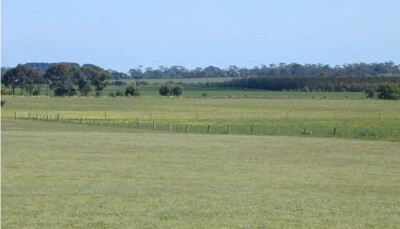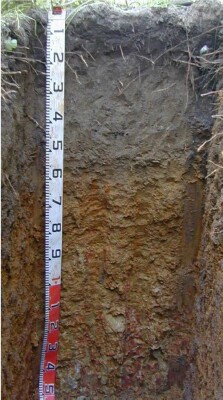MAN98 (Plot 3)
| Site: MAN98 (Plot 3) | Land Unit: Warrakbook Basalts |
| Aust. Soil Class.: | |
 | General Land Unit Description: This land unit consists of gently undulating basalt plains in the Macarthur area. In some drainage lines, the basalt has been dissected sufficiently to expose the underlying sediments. The soils on the basalt plains are commonly Brown Kurosols or Chormosols, intermixed with Sodosols, particularly on the lower slopes and drainage depressions. This site has two year old Eucalyptus globulus in a plantation on ex-agricultural land. |
| Geology: Quaternary basalt | Landform pattern: Level plain |
| Position in landscape: | Internal drainage: |
Soil Profile Morphology
| A11 | 0-15 cm | Very dark brown (10YR2/2) loamy sand, weak polyhedral structure (10-20 mm), very weak consistence when moist, many medium roots. Clear and smooth transition to: |  |
| A12 | 15-35 cm | Very dark brown (10YR2/2) with many coarse dark faint yellowish brown (10YR4/4) mottles, sandy loam, weak polyhedral structure (10-20 mm), very weak consistence when wet, many very fine macropores, areal porosity 1.0 %, common fine roots. Clear and smooth transition to: | |
| A2 | 35-45 cm | Very dark brown (10YR2/2) with many coarse dark faint yellowish brown (10YR4/4) mottles, sandy clay loam, weak polyhedral structure (10-20 mm), very weak consistence when wet, many very fine macropores, areal porosity 1.0%, common very fine roots. Clear and smooth transition to: | |
| Subsoil | |||
| B1 | 45-55 cm | Dark brown (10YR4/3) with many coarse faint dark yellowish brown (10YR4/8) mottles sandy clay, unable to assess structure, consistence or macroporosity due to very many segregations present, very many coarse ferruginous nodules, few very fine roots. Abrupt and smooth transition to: | |
| B21 | 55-80 cm | Yellowish brown (10YR5/6) with many coarse distinct yellowish red (5YR4/6) mottles, light medium clay, moderate polyhedral structure (20-50 mm) parting to moderate polyhedral structure (10-20 mm), weak consistence when moist, few medium ferruginous nodules, common very fine macropores, areal porosity 0.1%, few very fine roots. Gradual and smooth transition to: | |
| B22 | 80-110 cm | Brownish yellow (10YR6/6) with many coarse distinct yellowish red (5YR4/6) mottles light medium clay, strong subangular blocky structure (10-20 mm) parting to moderate polyhedral structure (5-10 mm), weak consistence when moist, very few medium ferruginous nodules, few very fine macropores, areal porosity 0.01%, few very fine roots. Gradual and smooth transition to: | |
| B23 | 110-150 cm | Very pale brown (10YR7/3) with many coarse prominent yellowish red (5YR4/8) mottles, medium clay, strong lenticular structure (20-50 mm) parting to strong polyhedral structure (10-20 mm), weak consistence when moist, very few medium ferruginous nodules, few very fine macropores, areal porosity 0.02%, few very fine roots. | |
| 150-260 cm | Similar to above. | ||
| 260-420 cm | Grey heavy clay with red mottles, weaker structure, ironstone present, weathering rock, live roots observed to 300 cm, remnant roots observed to 400 cm, no impeding layer to root growth. |
Notes: Roots do not appear to be impeded by the very many segregations in the B1 horizon.
Sampled by: Ian Sargeant, Paul Feikema, Martin Clark and Kiet Quach (October, 2000).


